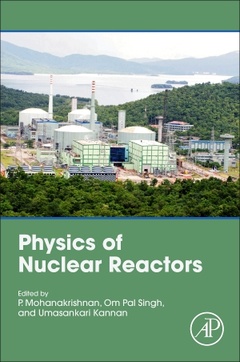Physics of Nuclear Reactors
Coordonnateurs : Mohanakrishnan P., Singh Om Pal, Umasankari K.

Physics of Nuclear Reactors presents a comprehensive analysis of nuclear reactor physics. Editors P. Mohanakrishnan, Om Pal Singh, and Kannan Umasankari and a team of expert contributors combine their knowledge to guide the reader through a toolkit of methods for solving transport equations, understanding the physics of reactor design principles, and developing reactor safety strategies. The inclusion of experimental and operational reactor physics makes this a unique reference for those working and researching nuclear power and the fuel cycle in existing power generation sites and experimental facilities. The book also includes radiation physics, shielding techniques and an analysis of shield design, neutron monitoring and core operations.
Those involved in the development and operation of nuclear reactors and the fuel cycle will gain a thorough understanding of all elements of nuclear reactor physics, thus enabling them to apply the analysis and solution methods provided to their own work and research. This book looks to future reactors in development and analyzes their status and challenges before providing possible worked-through solutions.
Cover image: Kaiga Atomic Power Station Units 1 ? 4, Karnataka, India. In 2018, Unit 1 of the Kaiga Station surpassed the world record of continuous operation, at 962 days. Image courtesy of DAE, India.
2. Nuclear data
3. Types of nuclear reactors
4. Homogeneous reactor and neutron diffusion equation
5. Methods of solving neutron transport equation
6. Fuel burnup, fuel management and fuel cycle physics
7. Nuclear reactor kinetics
8. Nuclear reactor safety
9. Design methods and computer codes
10. Experimental and operational reactor physics
11. Radiation safety and radiation shielding design
12. Nuclear reactors of the future
Dr. Om Pal Singh has been a scientist at the Reactor Physics Division of Indira Gandhi Center for Atomic Research (IGCAR), Kalpakkam, Tamil Nadu, India for 31 years. At the time of transfer to Atomic Energy Regulatory Board (AERB), Mumbai, India, he was Head of the Reactor Physics Division in IGCAR. In AERB, he was secretary of the Board and Director of one of the Divisions for 6.5 years. Dr. Singh then became Visiting Professor at Indian Institute of Technology (IIT) Kanpur, Kanpur, UP, India for 5.5 years. He was recognized as a PhD guide by University of Madras and Bombay and co-guide at IIT-Kanpur and guided several PhD theses. He is specialized in theory and experimental work and is expert in reactor physics, deterministic safety analysis, Probabilistic Safety Analysis (PSA), Signal Processing Techniques and Regulatory Processes for nuclear and radiation facilities.
He served as member of the 'Steering Committee of International Atomic Energy Agency (IAEA) on HRD in member states with nuclear po
- Includes methods for solving neutron transport problems, nuclear cross-section data and solutions of transport theory
- Dedicates a chapter to reactor safety that covers mitigation, probabilistic safety assessment and uncertainty analysis
- Covers experimental and operational physics with details on noise analysis and failed fuel detection
Date de parution : 05-2021
Ouvrage de 786 p.
19x23.3 cm
Thèmes de Physics of Nuclear Reactors :
Mots-clés :
ABBN-93; Actinides; ADSS; Analytical and numerical solutions; Batch fueling; Binding energy; Bondarenko’s dilution cross section; Breed and burn concept; Burnable poisons; Burnup; Cadmium ratio; CANDLE reactors; Chain reaction; Closed fuel cycle; Collision probability method; Condensation; CONSYST-2; Critical facilities; Criticality; Cross-section evaluation; Cross-section prediction; Cross-sections; Decay heat; Deterministic and probabilistic safety analysis; Different states of reactors; Discrete ordinates method; Doubling time; ENDF; Energy levels; Failed fuel detection; FARCOB; Fick's law; Fission products; Fission reactor; Flux and dose computations; Foil activation methods; Gen IV reactors; Homogeneous reactor; Homogenization; Inherent and passive safety; Integro-differential and integral transport; Lattice physics; Material and geometrical buckling; reflector savings; Measurement of cross-sections; Method of characteristics; Monte Carlo's methods; Multigrouping; Neutron cross-sections; Neutron detectors; Neutron diffusion equation; Neutron transport equation; Neutronic coupling; NR; NRIM; and IR approximations; finite-difference scheme; Nuclear data; Nuclear data preprocessing; Nuclear fission; Nuclear reactions; Nuclear reactor safety; Nuclear stability; Pn method; Point kinetics; Radiation dose and regulatory aspects; Radiation interactions; Radioactivity; Reaction models; Reactivity feedback; Reactivity measurements; Reactor kinetics; Reactor start-up; Reliability analysis; Self-shielding; Slowing down equation; Small and modular reactors; Space time kinetics; Spallation neutron sources; Spectrum unfolding; Stability analysis; Standing wave reactors; Subgroup method; Thermal and fast reactors; Thorium; Tokomaks; Traveling wave reactors; Uncertainty evaluation; U-Pu cycle; waste transmutation; Whole-core simulation; WIMS



